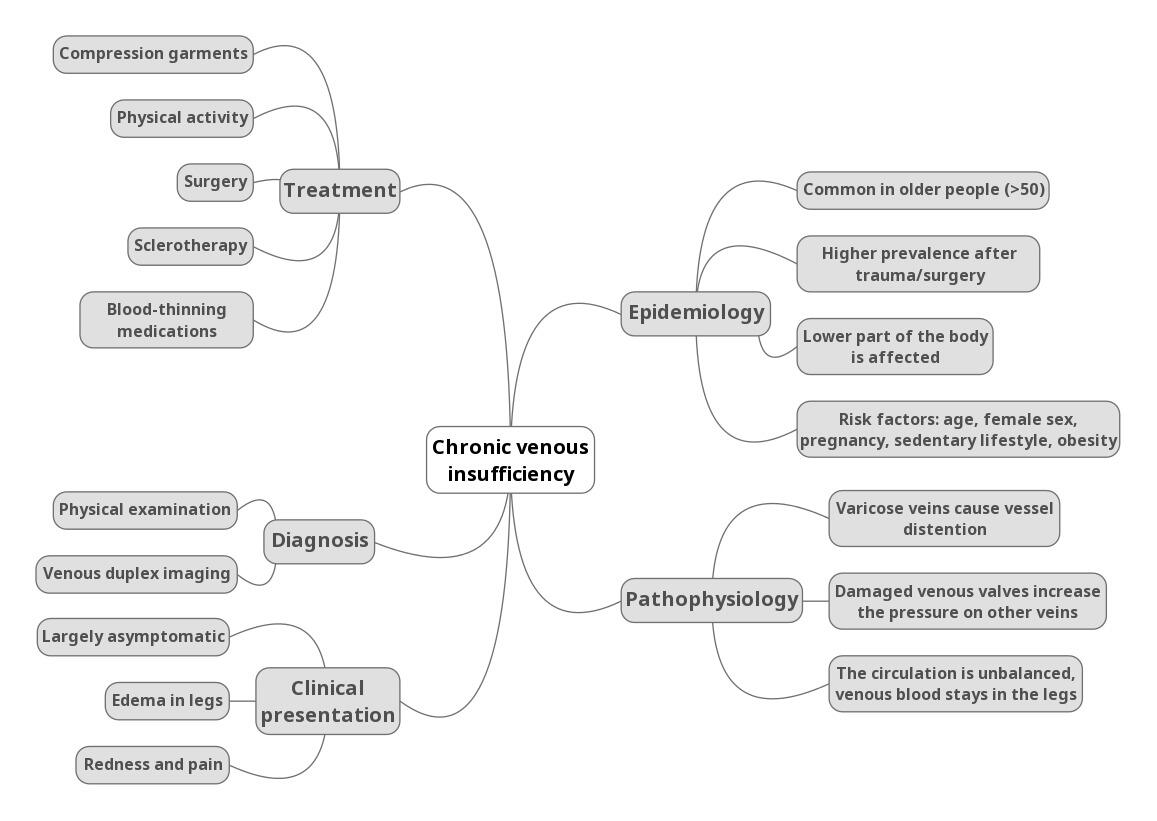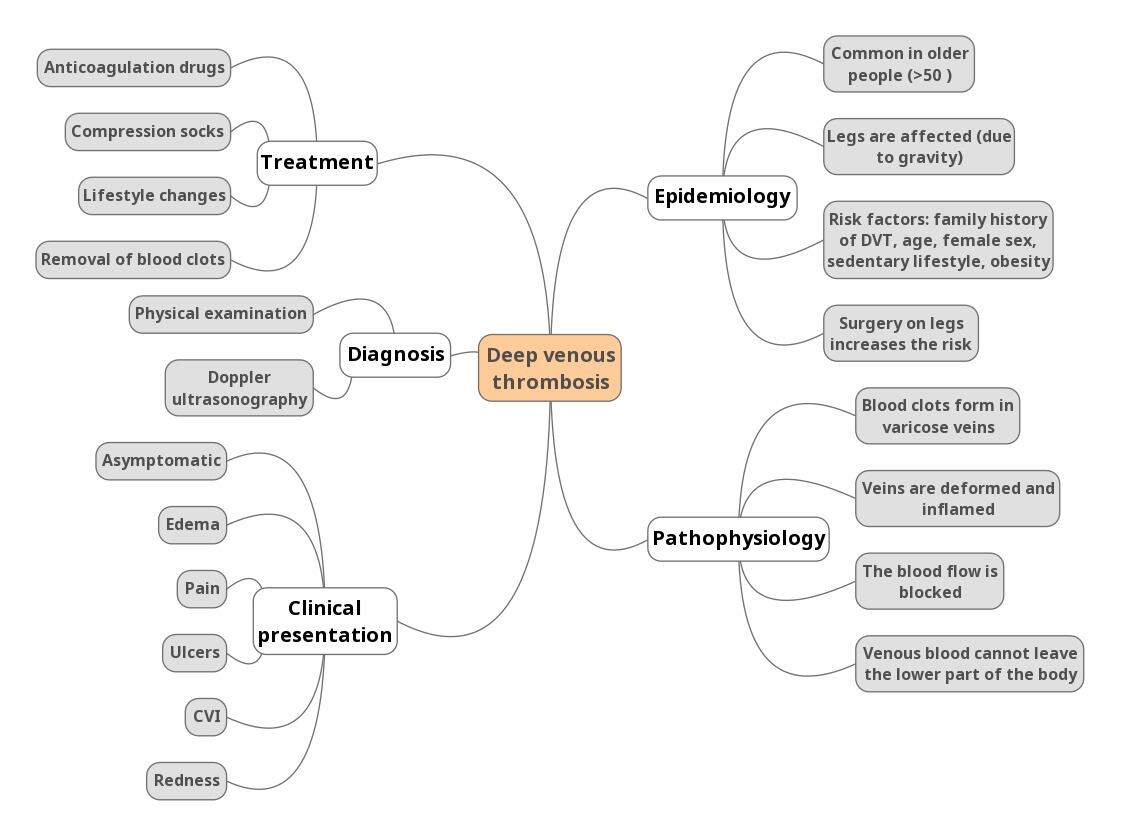Disorders of the veins such as chronic venous insufficiency (CVI) or deep venous thrombosis (DVT) constitute a substantial medical problem in the modern world. Their asymptomatic behavior further increases the difficulty of diagnosis and treatment, which causes these conditions to affect more patients each year (Eberhardt & Raffetto, 2014). CVI and DVT have different pathophysiology, the first disorder being among the outcomes of the second one. Nevertheless, they both are connected to a similar set of risk factors that affect the veins. Moreover, their prevalence rises with age – a patient factor that changes the pathophysiology significantly (Engbers et al., 2015). Medical professionals who work with older patients with CVI or DVT should understand that these disorders become more apparent with age, but their treatment also becomes more challenging due to changes in patients’ responses to drug therapy and their comorbidities.
Pathophysiology of CVI and DVT
CVI occurs in varicose veins – venous vessels that are palpable and distended due to pooled blood (Huether & McCance, 2017). The causes of varicose veins include leg trauma, surgery, and gravity leading to distention. Any type of damage to the veins in the leg increases pressure on other sections of these vessels as the blood passes through them. Under the influence of gravity, the veins swell, eventually damaging venous valves. Thus, the blood cannot circulate adequately, leading to the development of CVI (Eberhardt & Raffetto, 2014). As a result, one’s ankles and feet may become pigmented and edematous.
DVT mostly occurs in the lower part of the body, being affected by gravity as well. It is influenced by several features, including old age, female sex, trauma, pregnancy, and sedentary lifestyle (Lijfering et al., 2016). The veins begin forming blood clots after being affected by the mentioned above factors. Their aggregation leads to the veins becoming inflamed which increases the thrombus formation (Huether & McCance, 2017). This process may have symptoms such as pain or redness, but they are infrequent. Nevertheless, people with DVT may develop edema, CVI, and ulcers. This condition is more prevalent than arterial thrombosis because the pressure in the veins is usually lower.
Patient Factor, Diagnosis, and Treatment
Age is one of the risk factors that influence the development of both CVI and DVT. DVT is common in older people due to their decreased mobility and history of previous traumas or diseases (Engbers et al., 2015). The pathophysiology is affected as well because older people are more likely to have varicose veins affected by frailty and lack of physical activity. Thus, both disorders may develop, especially if left untreated. Other conditions may also complicate the diagnosis of vein-related problems because both CVI and DVT do not have highly specific symptoms and are extremely common.
Diagnosis of CVI should involve physical examinations and venous duplex imaging, while DVT can be established with Doppler ultrasonography. Treatment options for DVT focus on anticoagulation and use blood-thinning medications, compression stockings, and lifestyle changes (Huether & McCance, 2017). Strategy for treating CVI is also mostly noninvasive, incorporating compression garments and physical exercises. If a more invasive option is required, a patient can undergo surgery or sclerotherapy during which some varicose veins are destroyed. Older patients who experience problems with physical exercises should be advised to perform lighter types of activity such as walking (Engbers et al., 2015). Similarly, the mentioned above invasive options should be reserved for individuals with advanced stages of disorders.
Conclusion
CVI and DVT occur in older patients because of the sedentary lifestyle, pregnancy, age, and other factors. Their pathophysiology involves varicose veins which cannot transfer blood due to the increased pressure and inflammation. CVI can become an outcome of untreated DVT, and both conditions affect the lower part of the body due to gravity. The diagnosis of the disorders is difficult because they are often asymptomatic. The treatment is non-invasive and conservative, including compressing garments and blood-thinning medications. Age is one of the primary patient factors that affect the development of the disorders. Veins in the legs become stretched and swollen with time under pressure from blood and gravity. Moreover, the lack of mobility in older patients increases the production of blood clots. The treatment of these disorders should account for the patient’s comorbidities, frailty, and high responsiveness to medications.
Mind Maps


References
Eberhardt, R. T., & Raffetto, J. D. (2014). Chronic venous insufficiency. Circulation, 130(4), 333-346.
Engbers, M. J., Karasu, A., Blom, J. W., Cushman, M., Rosendaal, F. R., & van Hylckama Vlieg, A. (2015). Clinical features of venous insufficiency and the risk of venous thrombosis in older people. British Journal of Haematology, 171(3), 417-423.
Huether, S. E., & McCance, K. L. (2017). Understanding pathophysiology (6th ed.). St. Louis, MO: Mosby.
Lijfering, W. M., Biedermann, J. S., Kruip, M. J., Leebeek, F. W., Rosendaal, F. R., & Cannegieter, S. C. (2016). Can we prevent venous thrombosis with statins: An epidemiologic review into mechanism and clinical utility. Expert Review of Hematology, 9(11), 1023-1030.